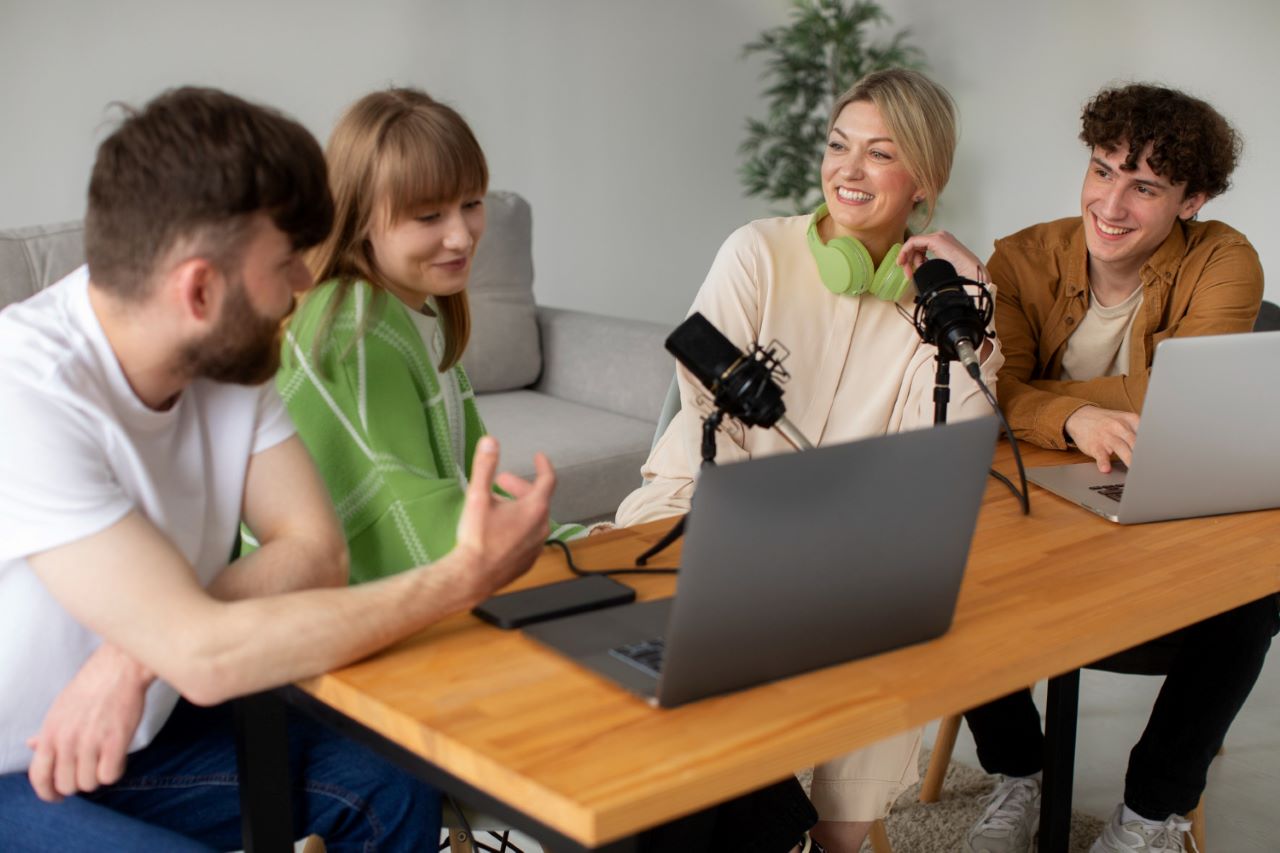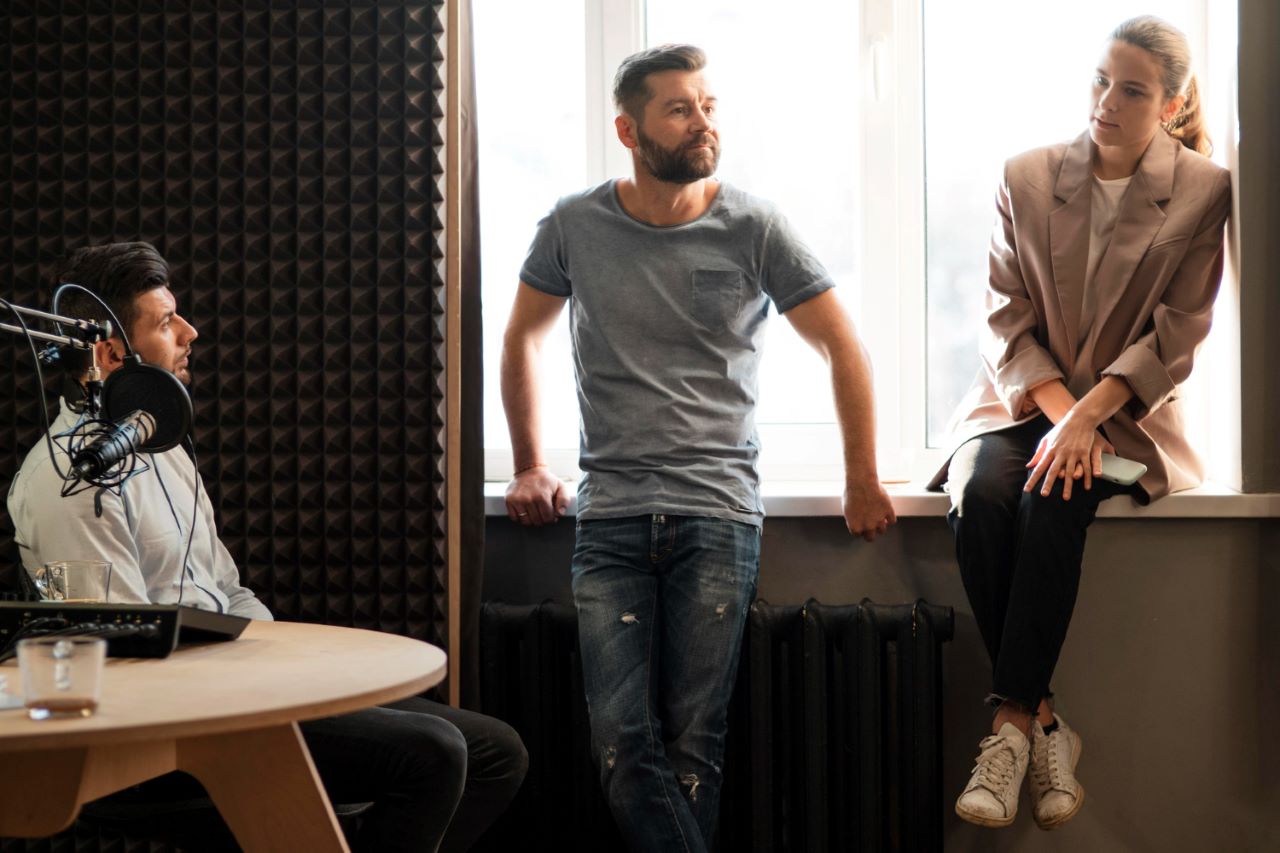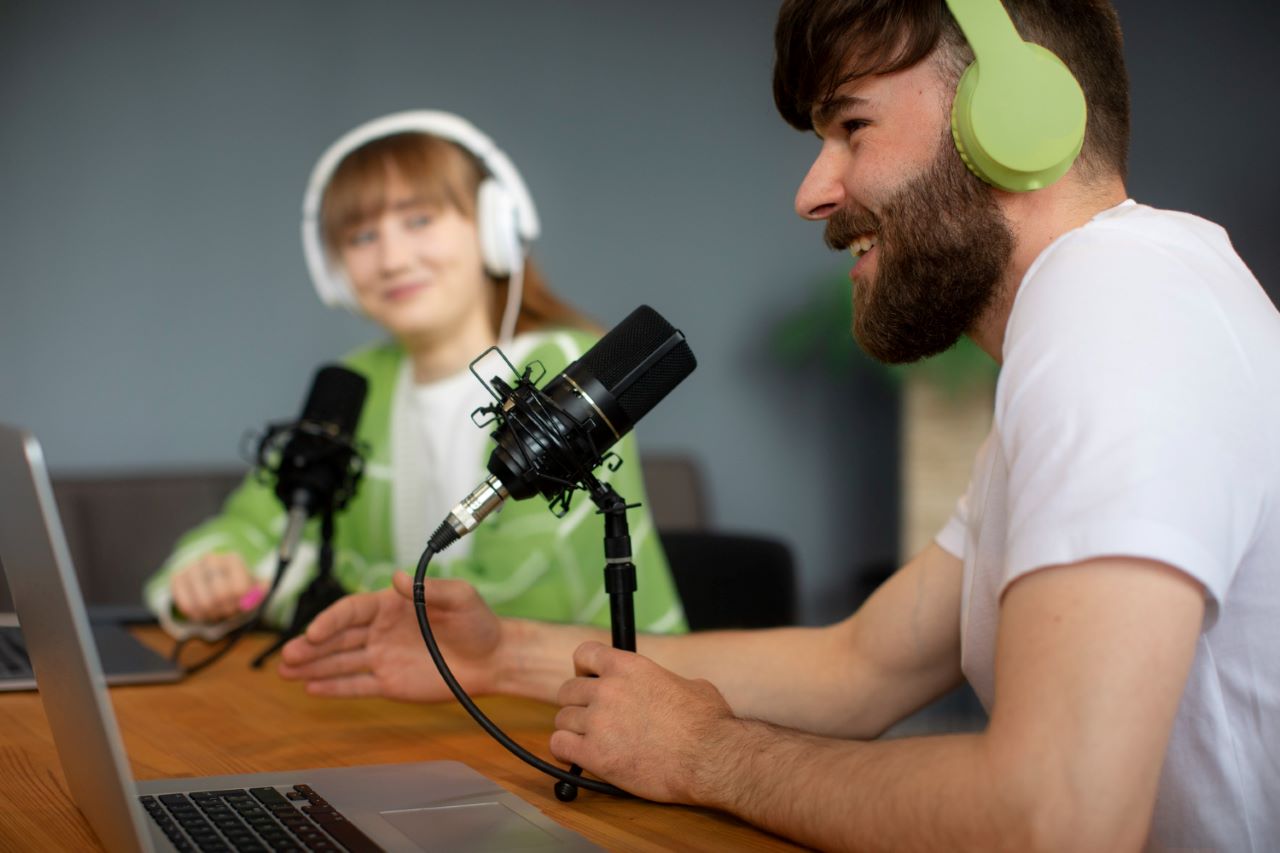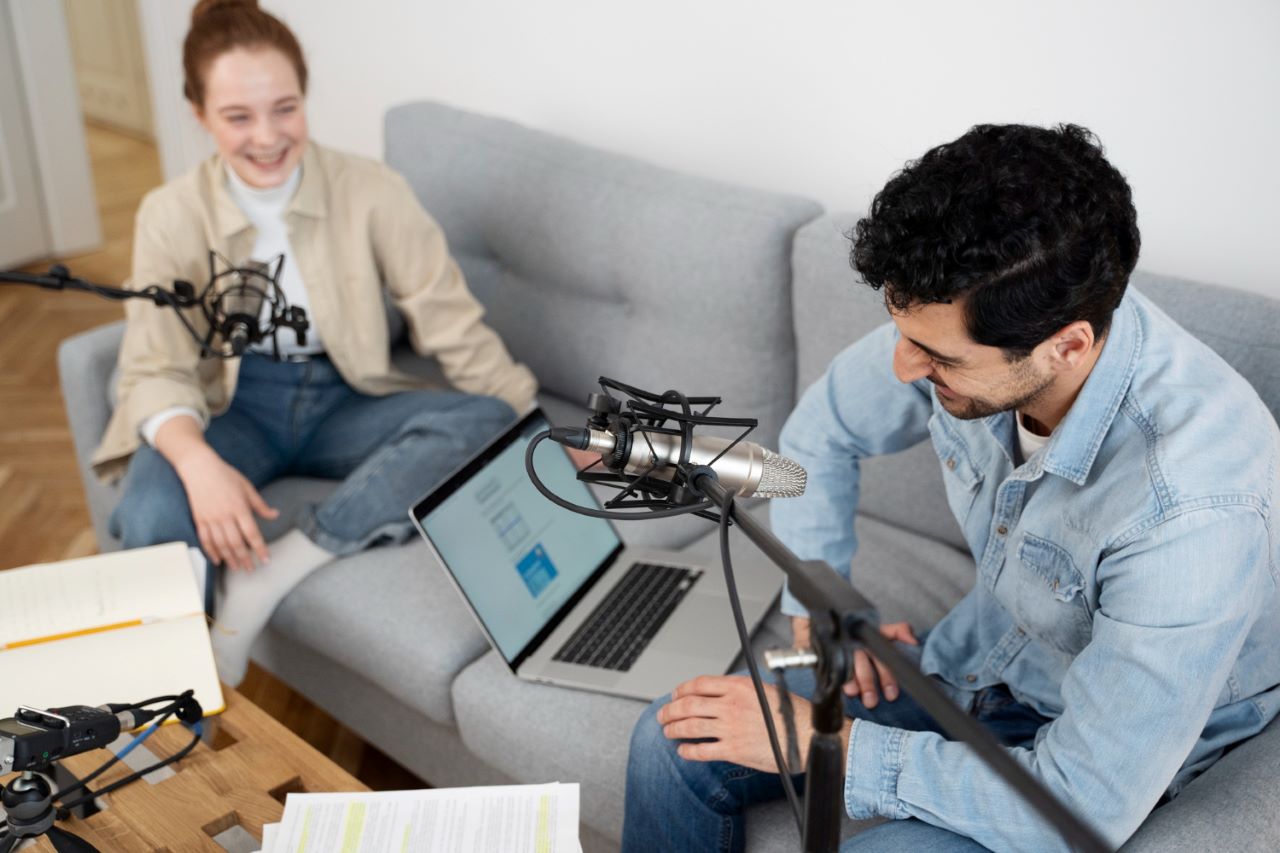Ever thought about starting a podcast with your pals? Going beyond the typical solo or duo setup and diving into a dynamic, 4-person conversation can offer an incredibly engaging listening experience. It’s like bringing your audience into the middle of a lively chat among friends. But as appealing as this setup may sound, it’s not without its challenges.
From ensuring crisp audio quality for each speaker to maintaining a smooth conversation flow, there’s a lot to consider. Fear not, podcast enthusiast! This guide is designed to walk you through everything you need to know when recording for a 4 person podcast setup.
Related: Podcast Starter Kit
Contents
4 Person Podcast Setup [Essential Equipment]
Ah, equipment. The bedrock of any podcast. Before delving into the heart of the conversation, you need to ensure you’ve got the right tools in your arsenal. And with four participants, that arsenal needs to be a bit more loaded.
Microphones
When diving into the world of podcasting, your microphone is akin to a painter’s brush. It’s a critical tool that directly impacts the quality and clarity of your content. Before discussing the various types, let’s understand why investing in a good microphone is paramount for a multi-speaker podcast.
Types of Microphones
In the vast sea of microphones, not every type is suitable for every purpose. Some are best suited for studio vocals, while others excel in outdoor environments, especially for video podcasting. Knowing the distinctions can make all the difference in capturing pristine audio for your podcast.
With a plethora of broadcast-quality microphone types out there, which ones should you focus on for a 4-person setup?
-
Dynamic microphone: Dynamic mics are a common choice, renowned for their durability and ability to isolate background noise.
-
Condenser microphone: Condenser mics, on the other hand, offer superior audio quality but can pick up more ambient sound.
For a multi-person setup, dynamic mics might be your best bet. They ensure that when Joe goes off on a passionate tangent about his favorite movie, Sarah’s snack munching isn’t picked up in the background.
Related: Best Microphones For Recording in Podcasting
Microphone Stands And Booms

Image by Freepik
Holding a mic for an extended podcast session? No thanks. Microphone stands, or booms, are essential. While tabletop stands are suitable for seated discussions, booms give you flexibility in terms of positioning, ensuring the microphone is always at the right angle and distance from the speaker. Plus, they free up table space, so Dave can have his collection of quirky coffee mugs within arm’s reach.
Pop Filters And Windshields
Nobody likes that jarring “p” and “b” popping sound in their ear. Pop filters help eliminate these harsh plosives, making your audio smoother. Windshields, or foam covers, prevent those unexpected gusts of breath from causing audio spikes. They’re like the unsung heroes of crystal-clear podcast audio. Check out our list of best pop filters for podcasting.
Audio Interface Or Mixer
An audio interface or mixer is the bridge between your microphones and your computer. It converts the analog signals from your mics into a digital format your recording software can use. For a 4-person podcast, a mixer might be more appropriate as it allows for multiple microphone connections and provides greater control over audio levels.
For a 4-person setup, you’d want at least four XLR inputs in the audio interfaces. Also, quality preamps are essential for amplifying your microphone signals without introducing noise. If you decide on condenser mics, make sure your mixer supports phantom power.
Related: Best Podcast Mixers
Headphones
Closed-back headphones are essential for podcast recording. They prevent audio bleeding, ensuring that what’s playing in your ears doesn’t get picked up by the microphone.
Ensuring Comfort For Lengthy Recording Sessions
Recording a podcast isn’t a sprint; it’s a marathon. Opt for headphones with cushioned ear pads and adjustable bands. Brands like Audio-Technica or Sennheiser are known for their comfortable and high-quality headphones. Check out our buying guide for the best podcast headphones.
Recording Software
Whether you’re a Mac or PC user, there’s a plethora of recording podcasting software out there. Audacity is a free and powerful choice, while Adobe Audition or Logic Pro X offers more advanced features for a price. Whatever you choose, ensure it supports multi-track recording – a must for a 4-person setup.
Related: What Is The Best Way To Record A Podcast?
Room And Acoustic Considerations

Image by Freepik
Imagine recording the perfect podcast episode, only to play it back and hear a cacophony of echoes and background noises. Your recording environment plays a pivotal role in your podcast’s audio quality. Before we delve into specifics, grasp the significance of the room and its acoustics in the recording equation.
Choosing the Right Recording Space
No one wants to hear a car honking or a dog barking in the middle of your gripping discussion. Choose a quiet space away from street noise. If you’re at home, a room without windows or a basement can be ideal.
Size and Shape Considerations For Audio Reflection
Avoid recording in square rooms or spaces with a lot of hard surfaces. These can cause audio reflections, making your recording sound echo-ey. Odd-shaped rooms or those with furniture can help break up sound waves and reduce reflections.
Acoustic Treatment
Soundproofing is about keeping outside noise out, while sound treatment improves the audio quality inside the same room. For podcasting, both are crucial. Soundproofing can be achieved with thick walls, sealed doors, and acoustic panels. Sound treatment often involves the use of diffusers and bass traps.
Panels And Diffusers
Acoustic panels absorb sound waves, reducing echo. Diffusers, on the other hand, scatter sound waves, preventing them from bouncing back directly and causing reflections. Place panels at reflection points, typically on walls directly to the sides of or behind the speakers. Diffusers work best when placed on the rear wall.
Bass Traps
Low-frequency sounds, or bass can be particularly troublesome in recordings. Bass traps absorb these frequencies, preventing them from muddying your audio. Bass traps are most effective when placed in room corners. For optimal effect, you’d want them in every corner of your recording space.
Recording Dynamics With Multiple Speakers
Introducing multiple speakers into a podcast adds layers of depth but also complexity. Ensuring each voice shines distinctly and contributes to a harmonious conversation is an art. Before we navigate the intricacies of mic techniques and communication cues, let’s discuss the dynamics of multi-speaker recordings.
Mic Technique And Positioning
The general rule of thumb is to position the mic about a fist’s distance away from the speaker’s mouth and angled slightly off to the side, avoiding direct breath blasts.
Adjustments For Varying Voice Volumes and Tones
Not everyone speaks at the same volume or tone. During sound checks, adjust microphone levels for each speaker. Louder speakers might need their microphone levels turned down, while softer speakers might need a boost.
Communication and Cue Techniques

Image by Freepik
With four people, there’s a higher chance of crosstalk. Develop non-verbal cues, like raising a hand when someone wants to interject, to ensure a smoother conversation flow. Having a designated host or moderator can help guide the conversation, introduce topics, and ensure everyone gets their turn to speak.
Pre-recording Briefs
A structured conversation is more engaging for listeners. Before hitting that record button, discuss the topics and segments you’ll cover. Set some basic rules – no talking over each other, respecting non-verbal cues, sticking to the topic at hand – to ensure a seamless recording experience.
4 Person Podcast Setup [Post-Production Tips]
The recording is just one side of the podcasting coin. The magic often happens in post-production, where raw audio is transformed into a polished episode. Before we embark on this transformative journey, understand the essential post-production steps that will elevate your multi-person podcast to professional standards.
Multi-track Editing
Benefits of isolating individual voices: Recording each person on a separate track allows for easier editing. You can adjust individual voice volumes, cut out mistakes, or even reposition segments without affecting the other speakers.
Basic Steps For Effective Multi-track Editing:
- Step one: Import your tracks into your chosen editing software.
- Step two: Sync them up, ensuring everyone is aligned.
- Step three: Go through each track, adjusting volumes, and cutting out any mistakes or unwanted segments.
- Step four: Apply any audio enhancements, like equalization or compression, to each track.
- Step five: Mix down to a single stereo track for exporting.
Noise Reduction And Audio Enhancement
Tools like RX by iZotope or the noise reduction feature in Adobe Audition can help eliminate background noise. Plugins like Waves Vocal Rider can automatically adjust voice volumes for consistency. With multiple speakers, maintaining a consistent audio level is crucial. Use compression to even out dynamic ranges and equalization to adjust tonal balances.
Exporting And Publishing
For podcasts, MP3 is the most commonly used format. A bitrate of 128kbps offers a good balance between audio quality and file size. Platforms like Libsyn, Podbean, or Anchor are popular choices. They offer robust analytics, monetization options, and distribution to various podcast directories.
Related: Podcast Studio Setup
FAQs
Can You Use One Mic For A Multi-person Podcast?

Image by Freepik
The short answer is yes, you can. However, it’s rarely the best choice for a variety of reasons:
- Sound Quality: One microphone will likely pick up all voices at varying volumes depending on proximity, which could make some speakers sound distant while others sound too loud.
- Overlapping Conversations: In a lively discussion, there might be instances where two people talking at the same time. With one USB microphone, it’s challenging to edit these overlaps in post-production.
- Ambient Noise: A single mic designed to pick up everyone will also likely pick up a lot of ambient noise. This can be distracting for listeners.
For a professional-sounding multi-person podcast, individual mics are highly recommended.
How Many Mics Do I Need For A Podcast?
The general rule of thumb is one microphone per person. So, for a 4-person podcast, you’d ideally have four microphones. This setup ensures:
- Individual Volume Control: Each speaker can be adjusted for volume separately in post-production, ensuring a balanced sound.
- Clearer Sound: Individual mics reduce the chances of picking up ambient noise or echo as they can be placed close to each speaker.
- Flexibility in Editing: If one person coughs or there’s an interruption while another is speaking, it’s easier to edit out with individual tracks.
However, the number of mics might vary depending on your podcast’s format. For instance, if there’s a main host and guests who speak less frequently, you might opt for fewer mics and ask guests to share.
How Do I Ensure Consistent Audio Quality Among Different Mics?
If you’re using different brands or models of microphones for your podcast, you might face variations in sound quality. Here’s how to achieve consistency:
- Post-Production Equalizing: This process allows you to balance out the tonal differences among podcast microphones.
- Use the Same Mic Model: If budget allows, invest in the same model for all speakers. This ensures uniform sound characteristics.
- Mic Positioning: Ensure each mic is at an optimal distance and angle from each speaker. This can reduce disparities in loudness or clarity.
What’s The Ideal Room Size For A 4-person Podcast?

Image by Freepik
Room size matters, especially for a multi-person setup. A medium to large room is ideal for a 4-person podcast:
- Space for Equipment: Each person will have a mic, stand, studio headphones, and potentially other equipment. You want to ensure everyone’s comfortably spaced and not feeling cramped.
- Acoustics: A larger room can reduce sound reflections, especially if it’s acoustically treated. However, too large a space might introduce echo, so ensure you balance size with proper sound treatment.
- Comfort: Remember, some podcast sessions can be lengthy. Ensuring everyone has enough personal space will keep the energy and comfort levels high.
Is A Mixer Essential For A Multi-person Podcast?
While it’s possible to run a podcast without a mixer, for multi-person setups, a mixer can be incredibly beneficial:
- Real-time Adjustments: You can adjust volumes on the fly, ensuring consistent levels throughout the recording.
- Connectivity: Mixers allow for multiple mics to connect, making setup and breakdown easier.
- Effects & Processing: Some mixers come with built-in effects or processing capabilities, which can enhance your audio quality even before post-production.
For 4-person podcasts, investing in a quality mixer is a wise decision to streamline the recording process and guarantee optimal audio output.
Conclusion
Starting a 4-person podcast might seem daunting, but with the right preparation and equipment, it’s entirely feasible – and can be incredibly rewarding. By following the guidelines and suggestions in this article, you’re well on your way to creating engaging multi-speaker content that’ll have listeners coming back for more. So gather your team, hit that record button, and let the conversations flow!